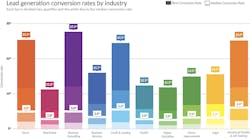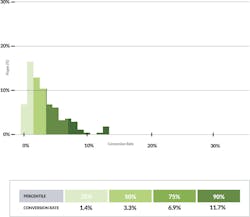Keep It Simple Stupid: The Trick to Converting Online Leads
Home improvement is not a tech industry, but also it is.
In the same way hailing a cab now means downloading an app, hiring a contractor is largely becoming a matter of going online. Customers, especially younger ones, want to, in a matter of seconds, compare your company to others and see what people are saying about your services. It’s a shift that’s taken them away from the traditional referral model and is redefining what it means to generate a lead.
In this digital age, think of Google as the new Yellow Pages—which makes websites the new listings. Every visitor is a potential lead—if you’re able to convert them (that is, capture their contact information).
According to the online lead-generation platform Unbounce, the home improvement industry’s median conversion rate is 3.3 percent. So if 100 people visit a remodeler’s website, it’s expected that about three will give their contact information.
When Unbounce compared that rate with the rate in nine other industries, it found that five were performing better—vocational studies and job training, credit and lending, business consulting, travel, and business services. That’s called room for improvement.
Chart: Courtesy Unbounce
In this year’s first quarter, Unbounce calculated that had all business websites in the home improvement space performed at the same level of the industry’s most effective, they would have generated 1,000 additional leads. That works out to more than 10 missed conversions a day, or as people on the business side of the industry would say: “a whole lot of money left on the table.”
But not every company is missing out.
The most finely tuned businesses in the industry are converting at rates in the double digits, as the graph, below, illustrates. And several are converting nearly 7 percent. But on the other end of that spectrum, some are hardly converting any visitors at all.
Chart: Courtesy Unbounce
So, what are the top companies doing right?
For starters, they’re not being cheesy, and they’re not being gloomy. As Unbounce found, words that communicate joyful concepts (such as save, friendly, clean, etc.) and those that communicate negative, angry ones (such as fee, damage, broken, etc.) don’t work. Businesses that included them in their web page’s copy saw their conversion rates drop.
The top businesses also aren’t falling into the trap of trying to create false urgency. That may seem counterintuitive, but half of all home improvement businesses that used even a small amount of anticipatory language, words such as "time" and "quote" and "deal," had conversion rates of 0 percent.
What the industry’s top converters are doing, however, is keeping it simple. A page that contained only 100 words of copy converted 30 percent more leads than pages with 250 words. And when that copy read below a ninth-grade level, the page performed better still. (Go here to check the reading level of your website’s copy)
The things Unbounce saw as positive weren’t particularly difficult to implement, but they were effective. And it begs the question: Why isn’t everyone in the home improvement industry doing them?


